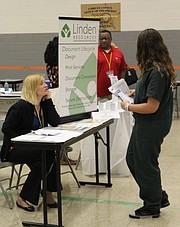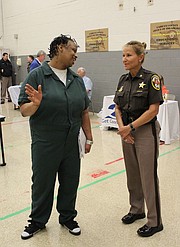Whittina McLilly, Re-Entry and Family Services Program Manager with OAR (Opportunities, Alternatives and Resources), speaking with an inmate at the fourth Inmate Resource Fair at the Fairfax Adult Detention Center. Photo by Alexandra Tecco/The Connection
Toccara Puller moves table to table at the Inmate Resource Fair at the Fairfax Adult Detention Center on Tuesday, Sept. 20. Puller and the small group of other female inmates make contacts with the 20 vendors in attendance which represent the diverse partnerships the Sheriff’s Office has made to help with their releases. Governmental agencies, businesses, non-profits all come together in the single room to share pamphlets, flyers and individualized advice for the 200 inmates, male and female, some of whom are veterans, that will visit the fair by the end of the day.
The partnerships, sitting behind tables lining the grey and beige painted room, help with the vast array of hurdles the inmates will face upon release: food, shelter, clothing, medical care, mental health care, employment, transportation, acquiring job skills and overcoming stigma.
“This is a great program,” explains Fairfax County Sheriff Stacey Kincaid. “Anytime we have an opportunity to help men and women get the services they need it’s a great feeling. We help them realize that every day is a new opportunity.”
PULLER leaves the fair with a stack of papers, “info on groups to help,” she explains. It’s info that’s useful to every inmate when they’re about to be released. “if they can take it seriously then they can be successful,” she says.
Puller has participated in many programs during her two years. She joined book club, has been studying for her CDL and has plans in three years to be “working for a company, have a 401k, be stable and collecting paychecks,” Puller explains.
They are simple goals, but meeting these basic needs are often the difference between thriving upon release and recidivism.
“Some leave here with nothing but the bag of personal belongings they came in with,” explains Lieutenant Jaime Popik, Supervisor of Inmate Programs and Recreation. That means no connections in the community, no support structure and lacking the means to acquire food and shelter. The inmates will also leave with the stigma of being incarcerated and trying to move back into the community, to be someone’s neighbor, explains Popik, which means they often feel that they have no ties.
Popik hopes the community keeps an open mind, giving the inmates a second chance.
“Think of them as family,” Popik explains, “who had the worst day of their life and made a horrible decision. They’re just normal human beings who made mistakes.”
For Puller, the fair helps build upon the resources she acquired during the past two years. She received the medical assistance she needed, learned from the programs she participated in that those who had a hard life can still rise above it. “These resources help people who don’t have any light,” Puller explains, thankful for the help.
THE FAIR has been growing slowly, a few more vendors each time the fair is held, Spring and Fall. For the March resource fair, next Spring, Popik is hoping for more mentoring opportunities. A chance to have a relationship with someone in the community once released. “Maybe next time someone who does credit repair help,” Puller suggests.
Northern Virginia is a unique area because the community is so active and supportive, Kincaid explains. “This is an opportunity to get involved,” says Kincaid. When the Sheriff’s Office visits the community it responds and “when offenders get out they share the resources that have helped them by word of mouth.” Consequently, the circle of those that benefit from the fair grows larger than just the 200 attendees.



